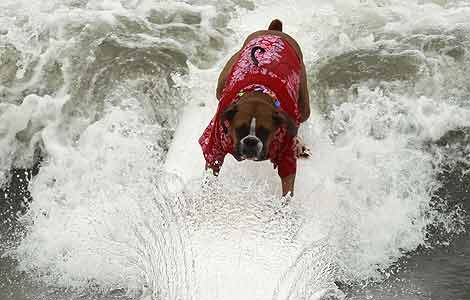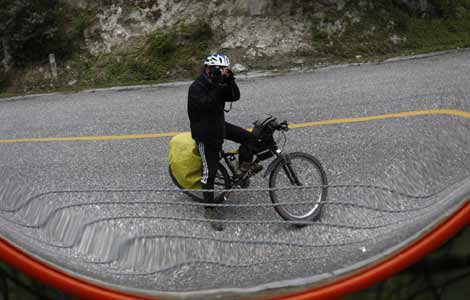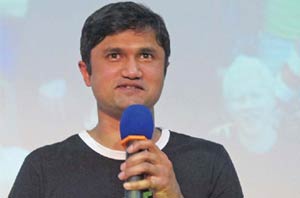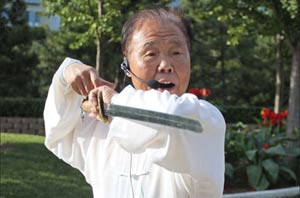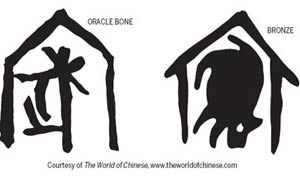Tourism sees surge for National Day
Updated: 2011-10-08 08:07
By An Baijie (China Daily)
|
|||||||||
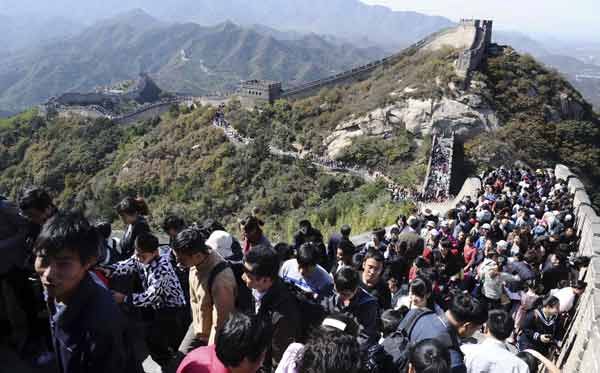 |
|
Tourists jostle each other in a crowd at the Badaling section of the Great Wall in Beijing on Monday, the third day of the National Day holiday. LIU DEBIN / XINHUA
|
From Oct 1 to 7, the days of the holiday, about 24.3 million tourists went to the 119 national scenic spots that are directly overseen by the National Tourism Administration. That was about 8.84 percent more than had done so in the same period of 2010.
Qiu Meiying, a 45-year-old tourist from Shandong province, who came to Beijing with her husband during the holiday, said she was "shocked" when she went to Tiananmen Square on Saturday.
"We got up as early as 5 am, changed trains twice in the subway, and walked several kilometers near Tiananmen Square, only to find that there were too many tourists there," she said. "The police ordered us to not stay very long near the square because there were many other tourists behind us.
"Although I hate to travel to crowded places, I had no choice since the National Day holiday is the only long holiday that I could enjoy with my husband and our son. And I'll keep traveling during the next National Day holiday."
During the holiday this year, the revenue generated by selling tickets for national scenic spots increased, going up by 10.57 percent to 1.25 billion yuan ($196 million), according to statistics released by the administration on Friday.
In Nanjing, capital of East China's Jiangsu province, more than 65,000 tourists went on Thursday to the mausoleum of Sun Yat-sen, who was a leader in the 1911 Revolution that toppled the Qing Dynasty (1644-1911) and helped to establish a republican government in China. The number of tourists increased by nearly 200 percent compared with how many had gone to the site in 2010, the administration said.
Meanwhile, more than 127,800 tourists went to the Forbidden City on Sunday, far more than the maximum of 80,000 tourists that the administrative office for the site had previously said could be admitted there during a single day, according to a report by the Beijing Times.
To maintain order during the holiday, more than 500 security workers were stationed at the Forbidden City. By Thursday afternoon, more than 50 ticket scalpers had been detained by the police for manipulating ticket prices, said Jiang Yanjie, deputy head of the Tiananmen public security sub-bureau.
"They bought the tickets, raised the prices by 10 yuan to 80 yuan, and then sold them to those who were waiting in line to buy tickets," Jiang said.
In an attempt at saving tourists' time, the Forbidden City began allowing visitors to reserve 40,000 tickets through its official website in late September.
A tourist surnamed Zhang, who came to Beijing from Shandong's Jinan city, complained that he had to wait for more than 20 minutes when he was going to a toilet at the Badaling section of the Great Wall in Beijing.
"During our three-day stay in Beijing, what I did most was sleep in the car and take photos at random," he said. "When I got back to the hotel, I couldn't even remember what I'd seen."
Paid vacations should be offered to employees to allow more people to travel at times other than the National Day holiday, said Cai Jiming, a professor of holiday reform at Beijing-based Tsinghua University.
"Statistics show that less than half of all companies allow workers to enjoy paid vacations," Cai said. "That is not enough."
China Daily


